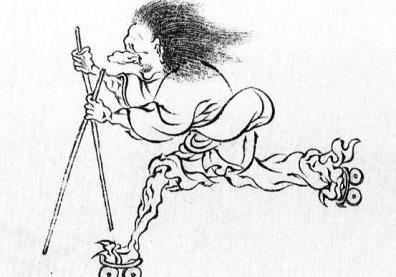Cross-reinventions of yôkai 妖怪/ yaoguai 妖怪 / yogoe 妖怪 요괴 in East Asia from 1900 to the present: art and illustration beyond graphic and narrative stereotypes

Argumentary
Yôkai/yaoguai/yogoe are strange, mysterious, changeable, sometimes mystifying beings that cannot be satisfactorily defined in writing, all the more so when comparative analyses are attempted. Japan is the country where the representation of these beings has been most successful on the international scene. In the archipelago, the quality and abundance of illustrations featuring yôkai marked the Edo period, but today these positive factors tend to freeze the iconography chosen for countless exhibitions, illustrated books and symposia. A fixed pattern is often repeated, in which premodern materials are followed by the output of three or four - always the same - manga and anime authors, grosso modo active from the Seventies onwards. This craze has recently spread to neighboring countries. In Taiwan, there has been a recent academic and artistic interest in these ambiguous creatures, resulting in symposia, exhibitions and publications on the theme, none of which have been translated. Some writers and manga/manhua authors draw much of their inspiration from them. In China, questions are being asked about their Chinese origins.
These days aim first and foremost to make visible three little-known aspects of yôkai. They will consist in:
- analyzing new themes, sometimes using untapped media (such as modern votive objects), works by artists inspired by these beings, illustrations and manga with a style different from the ultra-widespread and dominant graphic clichés, as well as fantastical reinterpretations of elements discovered by biological research.
- examine, in addition to contemporary productions, material dating back to the less-studied period from the early years of the twentieth century to the start of the Second World War
- show the parallel development or indicate the origin of yôkai entities in the Chinese-speaking worlds (including Taiwan) under the appellation of yaoguai and sketch out the beginnings of a comparison with Korean yogoe.
While images are the starting point for analysis in order to situate the material, we will also present some elements of the theories of Japanese ethnologists never translated into Western languages - an incomprehensible oversight in this field. And we'll highlight some convergences with the "monster studies" of Anglo-American anthropologists.
What should be included in the shifting category of yôkai? Has their terrifying character shifted mainly towards the kaijû 怪獣 (strange beasts) born in the 50s with Godzilla and then adopting other forms thereafter? It's often said that most yôkai (such as oni, kappa) have lost their once wild and dangerous character, transforming into cute playmates, but all in fact retain an ambiguous nature like Japanese deities. Moreover, yôkai's link to childhood is now inescapable.
Aside from giant monster movies, the globalization of American popular culture is at the root of contemporary hybrid forms, including many of the graphic motifs present in manga/manhuas. It has also created other elements that we won't be dealing with in the course of these days, but we might wonder whether the anodyne mascots (yuru-kyara) or Pokémon figurines (both released in the late 1990s) as logos for brands, tourist localities or game franchises might not also be part of this.
Program:
Friday morning, February 7
9:30 am: Welcome
9:55 am: Introduction (20 min) by Mary Picone (EHESS) & Marie Laureillard (Université Paris Nanterre)
Session chair: to be specified
10:15am: The monster (鬼oni) and the carpenter by Isabelle Charrier (Université Paris 8)
10:45am: coffee break
11am: Yôkai in ex-votos: Examining a rare presenceby Jean-Michel Butel (Inalco)
11:30am: Microscopic and macroscopic yôkai: the influence of scientific research on representations (1990-2024)by Mary Picone (EHESS)
12:00: questions and discussion
12:30: Lunch
Friday afternoon, February 7
Session chair: Christine Vial Kayser (Université de Cergy) (tbc)
2:30pm: The Witch and the Snake Eatersby François Lachaud (EFEO)
3pm: Non-human spirits described by themselves in inspired writing cults, China, 19e-20e centuries by Vincent Goossaert (EPHE)
3:30pm: questions and discussion
4pm: coffee break
4:30pm: From mountain to city: From yamauba 山姥 medieval to yamanba gyaru ヤマンバ ャル contemporary by Carina Roth (University of Geneva)
17h: Yôkai between painting and photography by Michael Lucken (Inalco)
17:30: Multiple embivalences of Korean geniustokkaebi and its vital expression in the printmaking of O Yun (1946-1986)by Ju-yeon Hwang (Université Paris Cité)
18h : questions and discussion
Saturday morning, February 8
9:30am: welcome and coffee
Session chair: Vincent Goossaert (EPHE) (to be confirmed)
9:45am: Classifying prodigies: categories of prodigious beings under the gaze of folklorists in popular Chinaby Vincent Durand-Dastès (Inalco)
10:15 am: Studying yôkai: a conceptual history of modern yokaiology by Matthias Hayek (EPHE)
10:45am: questions and discussion
11am: Figurative representations of yôkai in the Chinese painter Pu Ru (1893-1963) with regard to the past by Marie Laureillard (Université Paris Nanterre)
11:30 am: Masculine figures of the fox-spirit in literature on the Internet in China by Xu Shuang (Université Paris Cité)
12:00: questions and discussion, conclusion
Hybrid organized (to obtain the connection link, contact View e-mail)